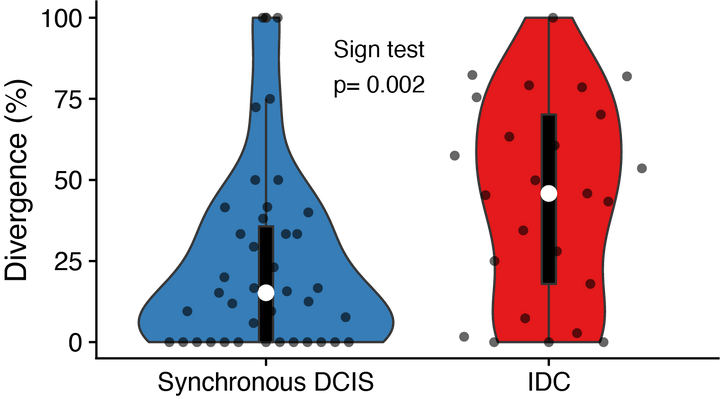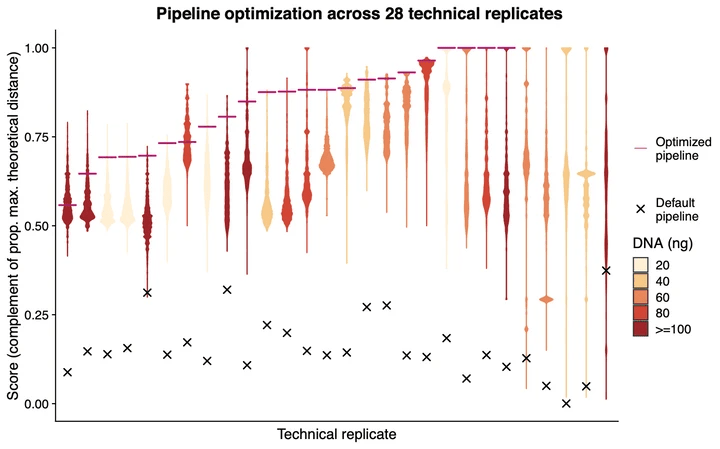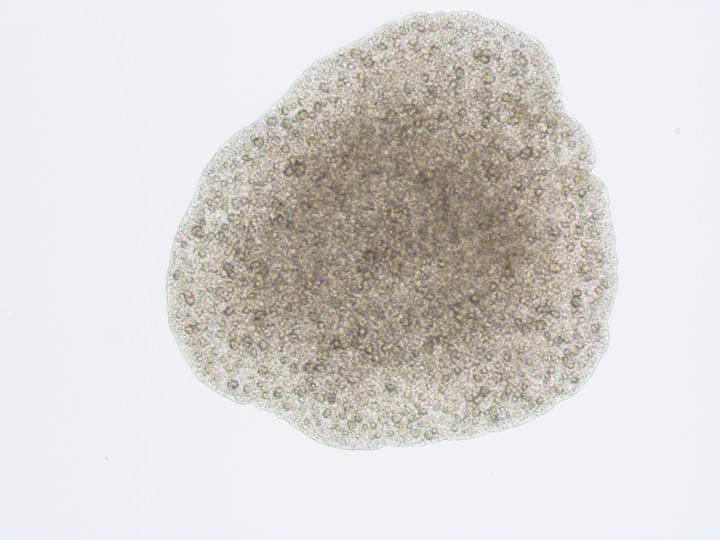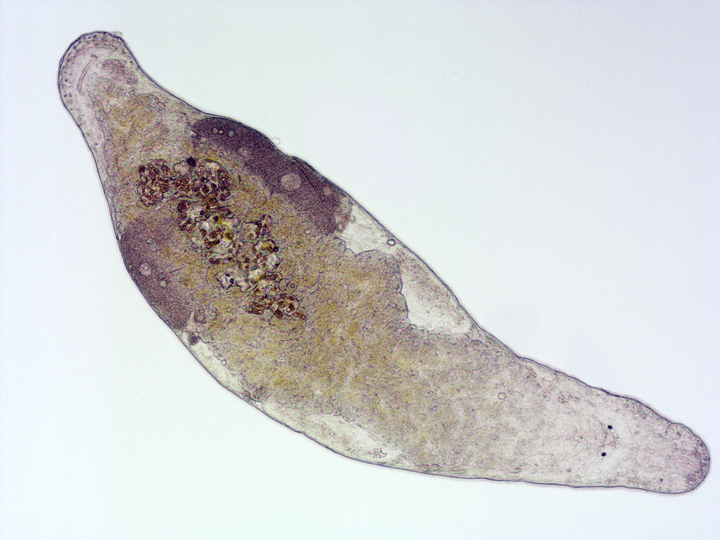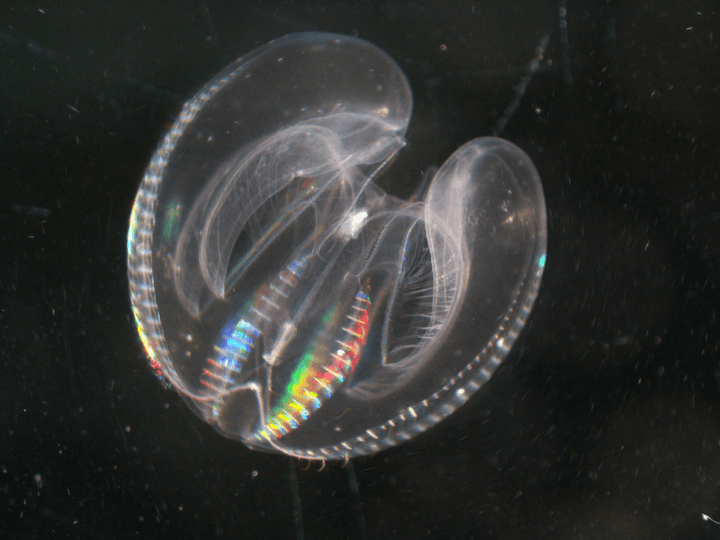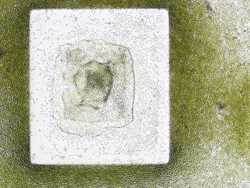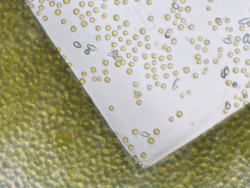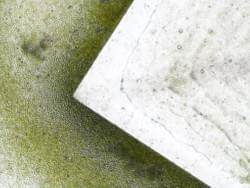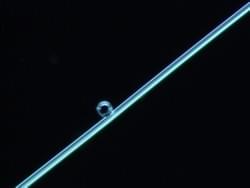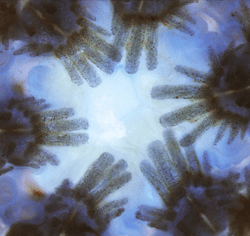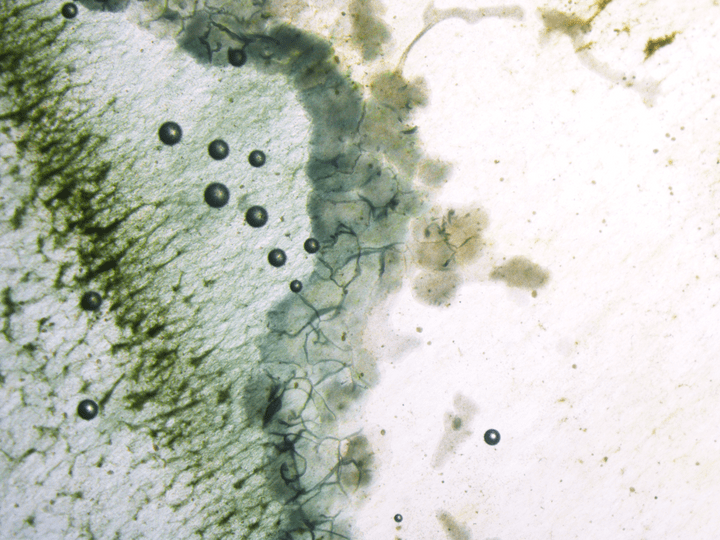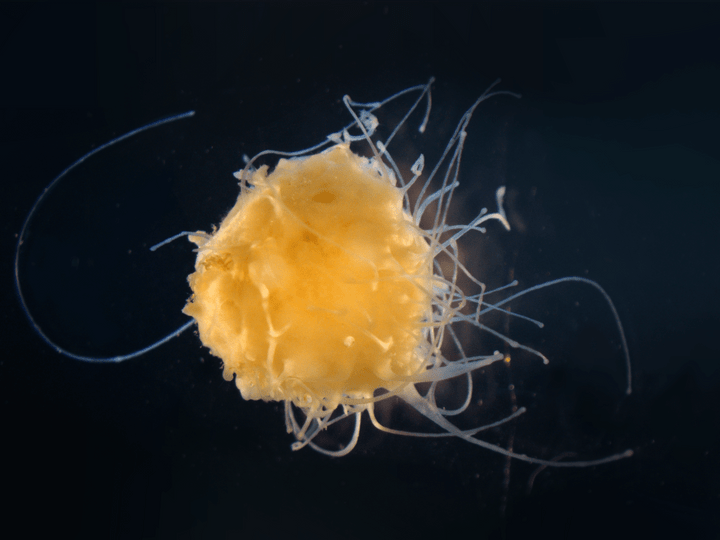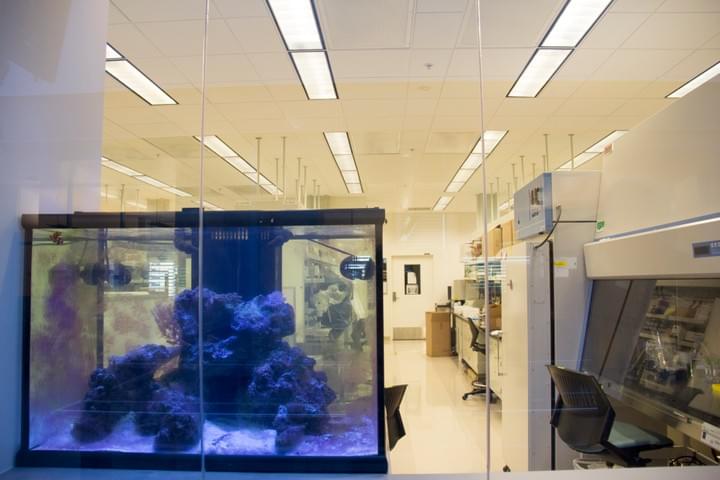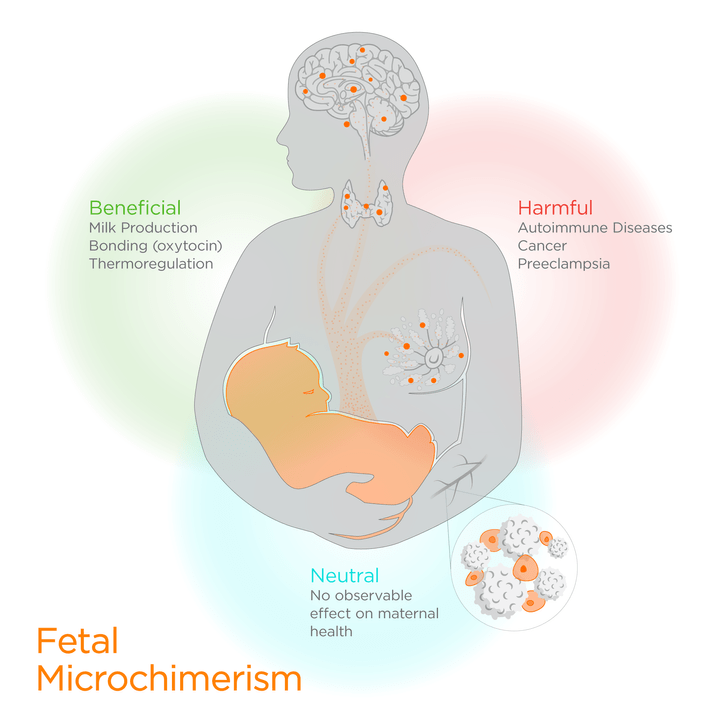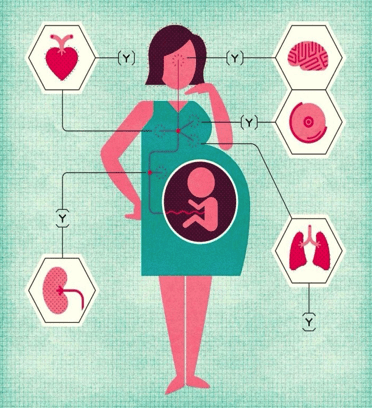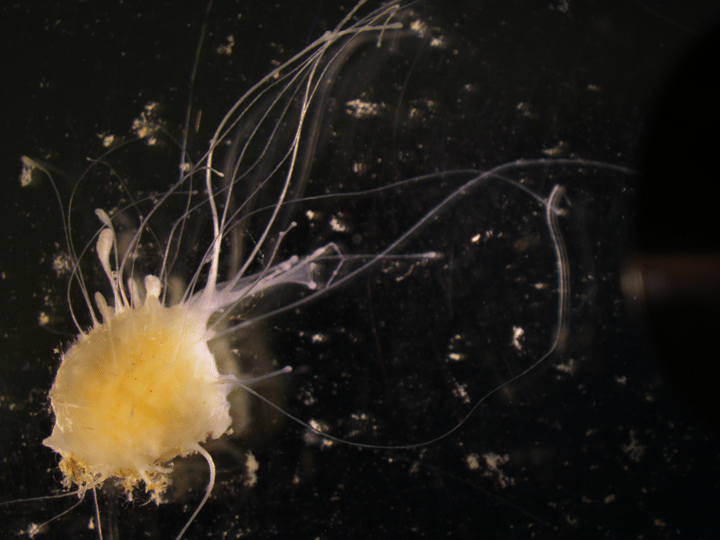
Cancer Evolution & Ecology
Angelo Fortunato, PhD
Associate Professor
Cancer evolution

Breast Cancer Heterogeneity
Intra-tumor heterogeneity
We hypothesize that the degree of intra-tumor heterogeneity in DCIS should predict which tumors are likely to become invasive and metastatic.

Cancer micro-ecology
Cancer ecology
Genomic and micro-ecological heterogeneity drives neoplastic progression.

Bioinformatics
Next generation sequencing
Development of new methods to extract high quality sequencing data from small amounts of DNA extracted from FFPE samples.
Model Organisms
Novel model organisms in cancer research

Placozoa
Trichoplax adhaerens
T. adhaerens is the simplest non-parasitic multicellular animal.

Sponges
Tethya wilhelma
T. whilelma is a demosponge.

Flatworms
Macrostomum lignano
M. lignano is a small free-living, marine flatworm within the phylum Platyhelminthes. M. lignano is used as a model organism for addressing fundamental questions of biology.

Comb jellies
Mnemiopsis leidyi
M. leidyi is a simultaneous hermaphrodite capable of self-fertilization and can reach a length up to 100 mm and 25 mm wide. Its diet consists of zooplankton, small crustaceans, fish eggs, and larvae. The native habitat of M. leidyi is the temperate to subtropical Atlantic coast of North and South America but it is an invasive species that adapts well to different conditions. Adults are capable of regenerating removed or damaged body parts.
Curriculum Vitae
Angelo Fortunato

Associate Professor
Education
Doctor of Philosophy degree, Experimental and Clinical Oncology, Department of Experimental Pathology and Oncology, University of Florence, Italy.
Doctor of Philosophy degree, Department of Ecology and Evolutionary Biology, Rice University, Texas, USA.
Qualified as a Professional Biologist, University of Florence/Ministry of Education, University and Research, Italy.
Laurea (equivalent to masters degree) in Biological Science, Dep. of Animal Biology and Genetics, University of Florence, Italy.
Current position
Associate Professor, eCampus University, Italy.
Biodesign Institute, Arizona State University, Tempe, Arizona, USA.
Professional experiences
Assistant Research Professor, Biodesign Institute, Arizona State University, Tempe, Arizona, USA
Research Scientist, Biodesign Institute, Arizona State University, Tempe, Arizona, USA.
Associate Specialist, Department of Surgery, University of California, San Francisco, CA, USA.
Postdoctoral Researcher, Department of Experimental and Clinical Biomedical Sciences “Mario Serio”, University of Florence, Italy.
Postdoctoral Researcher, Department of Experimental and Clinical Medicine (former Dep. of Experimental Pathology and Oncology), University of Florence, Italy.
Contract Researcher, Department of Gynecology, Perinatal Medicine and Human Reproduction, University of Florence, Italy.
Postdocoral Fellow, Department of Neuroscience, Molecular Medicine, University of Siena, Italy.
Research Associate, The Wellcome Trust Sanger Institute, Hinxton, Cambridge, UK.
Contract Researcher, postdoctoral, Institute Jacques Monod, CNRS, Universités Paris 6 et 7, Paris, France.
Visiting Scholar, Rice University, Houston, Texas, USA
Scientific interests
I am interested in cancer evolution and in the molecular basis of complex biological processes and diseases.
Cancer biology, molecular genetics, molecular biology, evolutionary biology, cancer gene therapy, integrative biology.
PUBLICATIONS
41. LAPLANE L., LAMOUREUX A., RICHKER HI., MARQUEZ ALCARAZ G., FORTUNATO A., SHAFFER Z., AKTIPIS A., MISCHEL P.S., PLUTYNSKI A.,TOWNSEND J.P. ,MALEY C.C. 2025. Applying multilevel selection to understand cancer evolution and progression. PLoS Biology 23(7): e3003290. https://doi.org/10.1371/journal.pbio.3003290.
40. FORTUNATO A., D. MALLO, L. CISNEROS, L. M. KING, A. KHAN, C. CURTIS, M. D. RYSER, J. Y LO, ALLISON HALL, J. R. MARKS, S. E. HWANG, C. C. MALEY. 2025. Evolutionary Measures Show that Recurrence of DCIS is Distinct from Progression to Breast Cancer Running title: DCIS Recurrence and Progression Are Evolutionarily Different, Breast Cancer Research, 27, 43. https://doi.org/10.1186/s13058-025-01966-2.
39. FORTUNATO, A.; TAYLOR, J.; SCIRONE, J.; SEYEDI, S.; AKTIPIS, A.; MALEY, C.C. 2025. Tethya wilhelma (Porifera) Is Highly Resistant to Radiation Exposure and Possibly Cancer. Biology, 14, 171. https://doi.org/10.3390/biology14020171.
38. KAPSETAKI S.E., FORTUNATO A., COMPTON Z., RUPP S. M., NOUR Z., RIGGS-DAVIS S.,STEPHENSON D., DUKE E. G., BODDY A. M., HARRISON T. M., MALEY C.C. and AKTIPIS A. 2023. Is chimerism associated with cancers across the tree of life? Plos one 18 (6), e0287901.
37. E.H. LIPS, T. KUMAR, A. MEGALIOS, L.L. VISSER, M. SHEINMAN, A. FORTUNATO, V. SHAH , M. HOOGSTRAAT, A. AHMED, N. ANVAR, W. BRUGMAN, K. CLEMENTS, H.R. DAVIES, L. FU, A. GRIGORIADIS, T.M. HARDMAN , L.M. KING , M. KRETE, P. KRISTEL, M. DE MAAKER, C.C. MALEY, D. MALLO , J.R. MARKS, B. MENEGAZ, L. MULDER, F. NIEBOER, S. NOWINSKI, S. PINDER, J. QUIST, M. ROMAN-ESCORZA, C. SALINAS-DE-SOUZA, M. SCHAEPVELD, M.K. SCHMIDT, E. SEI, A.M. SHAABAN, R. SHAMI, M. SRIDHARAN, M. XU, J. ZHANG, H. STOBART, D. COLLYAR, S. NIK-ZAINAL, L. F.A.WESSELS, E. S. HWANG, N. NAVIN, A. FUTREAL, A. THOMPSON, J. WESSELING, E. SAWYER. 2022. Genomic analysis defines clonal relationships of ductal carcinoma in situ and recurrent invasive breast cancer. Nature Genetics, Jun;54(6):850-860. doi:10.1038/s41588-022-01082-3.
36. FORTUNATO A., FLEMING A., AKTIPIS A. and MALEY C.C. 2021. Upregulation of DNA repair genes and cell extrusion underpin the remarkable radiation resistance of Trichoplax adhaerens. PLOS Biology, Nov 17;19(11):e3001471. doi: 10.1371/journal.pbio.3001471.
35. FORTUNATO A., MALLO D., RUPP S.M., KING L., HARDMAN T., LO J., HALL A., MARKS J.R., HWANG E.S., MALEY C.C. 2021. A new method to accurately identify single nucleotide variants using small FFPE breast samples. Brief in Bioinformatics, Nov 5;22(6):bbab221. doi: https://doi.org/10.1371/journal.pbio.300329010.1093/bib/bbab221.
34. ROZENBLATT-ROSEN O, REGEV A, OBERDOERFFER P, NAWY T, HUPALOWSKA A, ROOD JE, ASHENBERG O, CERAMI E, COFFEY RJ, DEMIR E, DING L, ESPLIN ED, FORD JM, GOECKS J, GHOSH S, GRAY JW, GUINNEY J, HANLON SE, HUGHES SK, HWANG ES, IACOBUZIO-DONAHUE CA, JANÉ-VALBUENA J, JOHNSON BE, LAU KS, LIVELY T, MAZZILLI SA, PE'ER D, SANTAGATA S, SHALEK AK, SCHAPIRO D, SNYDER MP, SORGER PK, SPIRA AE, SRIVASTAVA S, TAN K, WEST RB, WILLIAMS EH; HUMAN TUMOR ATLAS NETWORK. 2020. The Human Tumor Atlas Network: Charting Tumor Transitions across Space and Time at Single-Cell Resolution. Cell. 2020 Apr 16;181(2):236-249. doi: 10.1016/j.cell.2020.03.053.
33. FORTUNATO A. and AKTIPIS A. 2019. Social Feeding Behavior of Trichoplax adhaerens. Front. Ecol. Evol. 7:19. doi: 10.3389/fevo.2019.00019
32. FORTUNATO A. 2017. The role of hERG1 ion channels in epithelial-mesenchymal transition and the capacity of riluzole to reduce cisplatin resistance in colorectal cancer cells. Cellular Oncology. 2017 Aug;40(4):367-378. doi: 10.1007/s13402-017-0328-6. Epub 2017 Jun 7. http://rdcu.be/tioR
31. FORTUNATO A., BODDY A.M., MALLO D., AKTIPIS A., MALEY C.C., PEPPER W.J. 2017. Natural Selection in Cancer Biology: From Molecular Snowflakes to Trait Hallmarks. Cancer Evolution, Cold Spring Harbor Laboratory Press. Cold Spring Harbor Perspectives in Medicine. Feb. 1; 7(2). DOI: 10.1101/cshperspect.a029652. Published in advance, October 21, 2016.
30. IRDANI T., FORTUNATO A. and TORRE R. 2015. An ultra-rapid cryo-technique for complex organisms. Cryobiology, 2015, Oct 21. pii: S0011-2240(15)00394-6.
doi: 10.1016/j.cryobiol.2015.10.144
29. BODDY A.M. FORTUNATO A., WILSON SAVRES M AND AKTIPIS A. 2015. Fetal microchimerism and maternal health: A review and evolutionary analysis of cooperation and conflict beyond the womb. Bioessays, 37(10):1106-18. doi: 10.1002/bies.201500059. Epub 2015 Aug 28.
28. CROCIANI O., ZANIERI F., PILLOZZI S., LASTRAIOLI E., STEFANINI M., FIORE A., FORTUNATO A., D’ AMICO M., MASSELLI M., DELORENZO E., CHIU M., BUSSOLATI O., BECHETTI A. and ARCANGELI A. 2013. hERG1 channels modulate integrin signaling to trigger angiogenesis and tumor progression in colorectal cancer. Scientific Reports, 3: 3308, DOI: 10.1038/srep03308.
27. PILLOZZI S.*, FORTUNATO A.*, DE LORENZO E., BORRANI E., GIACHI M., SCARSELLI G., NOCI I., ARCANGELI A. 2013. Role for LH/hCG-R in distant metastasis in an endometrial cancer mouse model. Frontiers in Cancer Endocrinology, doi: 10.3389/fonc.2013.00285. * equally contributed to the paper.
26. FORTUNATO A. GASPAROLI L., FALSINI S., BONI L. and ARCANGELI A. 2013. An analytical method for the quantification of hERG1 channel gene expression in human colorectal cancer. Diagnostic Molecular Pathology, Epub: 2013 Nov 4.
25. FALSINI S., RISTORI S., CIANI L., FORTUNATO A. and ARCANGELI A. 2013. Advances in lipid-based platforms for RNAi therapeutics. Journal of Medicinal Chemistry, DOI: 10.1021/jm400791q, Epub: September 18, 2013
24. FIORE A., CARRARESI L., MORABITO A., POLVANI S., FORTUNATO A., LASTRAIOLI E., FEMIA AP, DE LORENZO E., CADERNI G and ARCANGELI A. 2013. Characterization of hERG1 channel role in mouse colorectal carcinogenesis. Cancer Medicine, 2 (5): 583–594.
23. FORTUNATO A. and S. TURILLAZZI. 2012. Dufour's gland possible role in the evolution of sting morphology and function in hover wasps (Hymenoptera Stenogastrinae). Arthropod Structure & Development 41: 259-264.
22. ARCANGELI A., NOCI I., FORTUNATO A. and SCARSELLI GF.2010. The LH/hCG Axis in Endometrial Cancer: A New Target in the Treatment of Recurrent or Metastatic Disease. Obstetrics and Gynecology International, doi:10.1155/2010/486164. Epub 2010 Jul 15.
21. FORTUNATO A. 2009. Quantitative high-throughput analysis of synthetic genetic interactions in Caenorhabditis elegans by RNA interference. Genomics, 93: 392-396.
20. FORTUNATO A. 2009. The cost of being bright. Journal of Insect Behavior, 22: 49-53.
19. LEHNER B., CROMBIE C., TISCHLER J., FORTUNATO A. and FRASER A.G. 2006. Systematic mapping of genetic interactions in Caenorhabditis elegans identifies common modifiers of diverse signaling pathways. Nature Genetics, 38(8):896-903.
18. LEHNER B.,CALIXTO A., CROMBIE C., TISCHLER J., FORTUNATO A., CHALFIE M. AND FRASER A.G. 2006. Loss of LIN-35, the Caenorhabditis elegans ortholog of the tumor suppressor p105Rb, results in enhanced RNA interference. Genome Biology, 7(1): R4
17. FORTUNATO A. and A.G. FRASER. 2005. Uncover genetic interactions in Caenorhabditis elegans by RNA interference. Bioscience Reports, 25(5/6): 299-307.
16. ROMANI R., ISIDORO N., RIOLO P., BIN F., FORTUNATO A., TURILLAZZI S., BEANI L. 2005. A new role for antennation in paper wasps (Hymenoptera: Vespidae): antennal courtship and sex dimorphic glands in antennomeres. Insectes Sociaux, 52: 96-102.
15. STRASSMANN J.E., FORTUNATO A., CERVO R., TURILLAZZI S., DAMON J.M. AND QUELLER D.C. 2004. The cost of queen loss in the social wasp Polistes dominulus. Journal of the Kansas Entomological Society, 77(4): 343-355.
14. FORTUNATO A., F.R. DANI, M.F. SLEDGE, L. FONDELLI and S. TURILLAZZI. 2004. Alarm communication in Ropalidia social wasps. (Hymenoptera: Vespidae). Insectes Sociaux, 51: 299-305.
13. QUELLER D. C., K.F. FOSTER, A. FORTUNATO AND J.E. STRASSMANN. 2003. Cooperation and conflict in the social amoeba, Dictyostelium discoideum. In: T. Kikuchi, T., N. Azuma and S. Higashi, S. (eds.), Genes, Behaviors and Evolution of Social Insects (pps. 173-200). Hokkaido University Press, Sapporo, Japan.
12. FORTUNATO A., D.C. QUELLER AND J.E. STRASSMANN. 2003. A linear dominance hierarchy among clones in chimeras of the social amoeba, Dictyostelium discoideum. Journal of Evolutionary Biology, 16(3): 438-445.
11. FORTUNATO A., J.E. STRASSMANN, L. SANTORELLI AND D.C. QUELLER. 2003. Co-occurrence in nature of different clones of the social amoeba, Dictyostelium discoideum. Molecular Ecology, 12: 1031-1038.
10. FOSTER K.R., FORTUNATO A., STRASSMANN J.E. AND QUELLER D.C.2002. The costs and benefits of being a chimera. Proceedings of Royal Society of London Series B: Biological Sciences, 269: 2357-2372.
9. BEANI L., M. F. SLEDGE, S. MAIANI, F. BOSCARO, M. LANDI, A. FORTUNATO, S.TURILLAZZI. 2002. Behavioral and chemical analyses of scent-marking in the lek system of a hover-wasp (Vespidae, Stenogastrinae). Insectes Sociaux, 49: 275-281.
8. FORTUNATO A., R. MAILE, S. TURILLAZZI, E.D. MORGAN, G. MONETI, G.R. JONES AND G. PIERACCINI. 2001. Defensive role of the secretion of Ectal Mandibular glands of the wasp Polistes dominulus. Journal of Chemical Ecology, 27: 569-579.
7. FORTUNATO A., TURILLAZZI S. AND G. DELFINO.2000. Ectal mandibular gland in Polistes dominulus (Christ) (Hymenoptera:Vespidae) ultrastructural modifications over the secretory cycle. Journal of Morphology, 244: 45-55.
6. SLEDGE M.F., A. FORTUNATO, S. TURILLAZZI, E. FRANCESCATO, R. HASHIM, G. MONETI AND G. JONES. 2000. The use of Dufour`s gland secretion to defend the nest in the hover wasps (Hymenoptera, Stenogastrinae). Journal of Insect Physiology, 46: 753-761.
5. SLEDGE M.F., DANI F.R., FORTUNATO A., MASCHWITZ U., CLARKE S.R., FRANCESCATO E., HASHIM R., MORGAN E.D., JONES G.R. AND S. TURILLAZZI. 1999. Venom induces alarm behaviour in the social wasp Polybioides raphigastra: (Hymenoptera: Vespidae) an investigation of alarm behaviour, venom volatiles, and sting autotomy. Physiological Entomology, 24: 234-239
4. FORTUNATO A. AND S. TURILLAZZI.2001. The Ectal Mandibular glands of Polistes dominulus (Hymenoptera Vespidae). Atti Dell`Accademia Nazionale Italiana di Entomologia. Rendiconti, Anno XLVIII
3. FORTUNATO A. AND C. COSTER-LONGMAN.2000. Reproductive behavior and related anatomical structures for the production of pheromones and luminous signals in the male of Metischnogaster (Vespidae: Stenogastrinae). Insect Social Life, 3: 27-28.
2. FORTUNATO A., G.DELFINO AND S.TURILLAZZI.2000. Exocrine glands in the parameres of male Liostenogaster flavolineata (Vespidae: Stenogastrinae). Insect Social Life, 3: 29-34.
1. DELFINO G., FORTUNATO A., FORMIGLI F. AND TURILLAZZI S.1998. Structural and ultrastructural features of the ectal mandibular gland in Liostenogaster (Vespidae, Stenogastrinae). Insect Social Life, 2: 45-51.
Thesis
Identification and characterization of genes involved in the development and progression of colorectal and endometrial cancers. Thesis of Doctor of Philosophy, University of Florence, Italy, 2012. Biblioteca Nazionale Centrale di Firenze, Collocazione: TDR 130 00753, Inventario: CTFD0018280
Evolutionary conflict in chimeras of the social amoeba, Dictyostelium discoideum.
Thesis of Doctor of Philosophy, Rice University, Houston, Texas, USA, 2002. URI: http://hdl.handle.net/1911/18079
Morfologia e ultrastruttura delle ghiandole mandibolari ectali di Polistes dominulus e possible funzione della loro secrezione. Thesis of Laurea, University of Florence, 1999.
Media

Amoebalike creatures form digestive ‘fronts’ to consume their prey, Science Magazine.

Catalyst: animal immune systems

The Lab Aquatic
https://biodesign.asu.edu/news/lab-aquatic

Fetal cells influence mom's health during pregnancy — and long after

BIOESSAYS: Fetal microchimerism and maternal health

Fetal microchimerism and maternal health, New York Times

Sponges can survive massive doses of radiation without getting cancer, NewScientist.
© 2017

